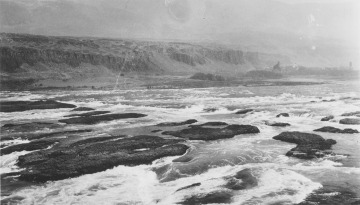9000 BC: At Celilo, trade thrives as the salmon run
Celilo, a village on what is now called the Columbia River, bustles during salmon runs. Each year, salmon swimming upstream to spawn turn the river, between present-day Washington and Oregon, silver with fish. Fishermen standing on rocks spear or net fish that can weigh 40 to 50 pounds each. Women dry the catch for storage and trade, and Celilo becomes a market with exotic goods from hundreds of miles away for sale. Today, oral histories and archaeological records say that this fishery fed many area tribes.
Oral histories recount stories of Celilo, where the river falls for over a mile, its water thundering between cliffs that rise hundreds of feet above, so that fishermen must shout to be heard. While the men fish, young women and boys haul the catch to the women drying it for storage and transport, and for sale. When the salmon are running, Celilo becomes a cosmopolitan center where people can trade for buffalo bones from grasslands more than 1,000 miles east, or dentalium seashells collected 600 miles northwest on an island now called Vancouver. Extended families gather from every direction; the population grows to thousands. Everyone eats well. The salmon chief governs when fishing starts and pauses fishing at dusk for the fishermen's safety and so that the salmon can run all night. It is his job to make sure that the fishery is bountiful for future generations.
- Theme
- Land and Water
- Region
- Northwest Coast
Site of Celilo, a trading center on what is now called the Columbia River. The falls were obliterated after construction of the Dalles Dam in 1956–1957.
Courtesy Washington Historical Society
